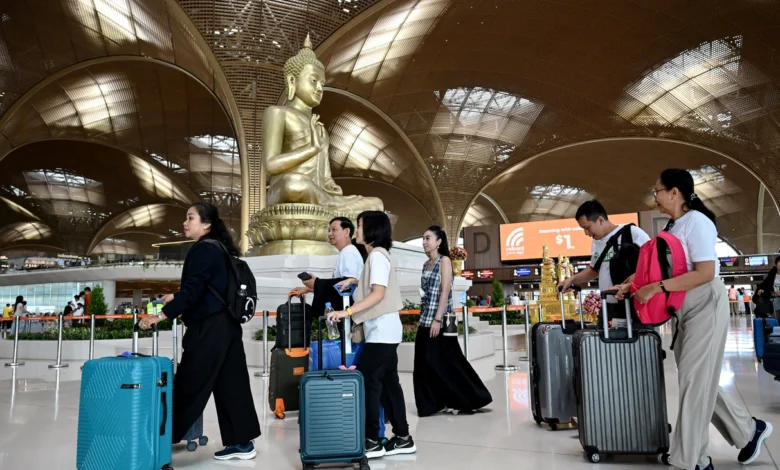
World’s Newest Mega-Airport in Cambodia Searches for Passengers
Cambodia’s newest aviation marvel, Techo International Airport, stands ready to welcome visitors after a $2 billion investment. This massive three-runway facility, located 18 miles south of Phnom Penh, replaces the original single-runway Phnom Penh International Airport that served for nearly 70 years.
Cambodia offers UNESCO-listed temples, beautiful beaches, and budget-friendly prices, yet attracts only 2.5 million international visitors each year. These numbers pale in comparison to Thailand’s 32 million and Vietnam’s 18 million tourists. The world-class 4F-level international facility spans over 2,600 hectares and accommodates large aircraft like the Airbus A380 and Boeing 747. The airport’s efficient design ensures passengers walk no more than 550 yards from center to end. The facility currently handles 15,000 passengers and 130 flights daily. While its present capacity stands at 13 million passengers annually, this number will grow to 30 million after 2030, reaching 50 million by 2050.
Cambodia replaces old airport with 4F-class mega facility
Image Source: Future Southeast Asia
Cambodia’s aviation infrastructure has taken a giant leap forward with the new Techo International Airport. The mega-project required a $2.3 billion investment and came to life through Cambodia Airport Investment Company (CAIC). This joint venture brings together the State Secretariat of Civil Aviation and Overseas Cambodian Investment Corporation.
The airport’s 4F-classification stands as the highest in the world and allows it to handle aircraft of all sizes. The facility’s soft launch happened in early September, and full commercial operations began on September 9, 2025. This new hub has now replaced all commercial activities from the old Phnom Penh International Airport.
British firm Foster + Partners created the airport’s striking design that features a 240,000-square-meter terminal with 22 gates. The terminal’s power needs are met almost entirely by an onsite solar farm, which shows Cambodia’s push toward eco-friendly infrastructure.
The project will grow in three phases and includes plans to add a second runway by 2030. The old Phnom Penh International Airport now serves military aircraft, domestic flights, and private jets.
The airport’s first week showed strong performance numbers. It handled about 130 flights and served 15,000 passengers each day, marking a promising start to Cambodia’s vision of becoming an aviation hub.
Government outlines five-point plan to attract passengers
Image Source: CNN
“Cambodia is committed to offering experiences that inspire and delight travelers.” — Minea Kim, Chief Executive Officer of the Cambodia Tourism Board
Prime Minister Hun Manet showed a complete five-point strategy that will tap into the full potential of the new airport investment. He outlined specific plans to reshape the scene of the facility into a regional aviation powerhouse during the airport’s inauguration.
The Prime Minister asked the State Secretariat of Civil Aviation to work together with relevant ministries. Their task is to bring back flights that were suspended during the pandemic and create new routes, especially when you have direct flights from major tourist cities. On top of that, he directed the Ministry of Tourism to coordinate with other institutions. This coordination will help expand direct and combined flight options, making travel easier for international visitors.
Safety stands as the third pillar of the strategy. The Ministry of Interior will monitor global threats like terrorism and transnational crime to protect passenger security. The fourth point focuses on keeping Khmer national identity throughout the airport experience. This includes courteous service and proper management of all facilities.
The final directive pushes the Council for Development of Cambodia to showcase the country’s strong investment climate. Both Techo and Siem Reap Angkor International Airports serve as symbols of progress.
This strategy aligns with Cambodia’s broader tourism goals. The country welcomed 6.7 million foreign visitors in 2024, showing a 23% increase from 2023. Cambodia wants to attract 7.5 million international tourists in 2025.
Security concerns and regional tensions challenge growth
Cambodia’s airport expansion plans face major obstacles beyond building new infrastructure. South Korea placed a “code black” travel ban on parts of Cambodia in October 2025. The ban ordered citizens to leave areas like Poipet, Bavet, and the Bokor Mountain region. This decision came after a South Korean student died from alleged torture at a scam center.
The scam compounds throughout Cambodia hold about 200,000 people, with an estimated 1,000 South Korean nationals among them. Officials can’t locate 80 South Koreans, while another 60 wait to return home after Cambodian authorities detained them.
Several countries have raised red flags about travel safety. The U.S. State Department tells citizens not to travel within 50km of Cambodia’s border with Thailand because of military conflicts. The UK, Canada, and Australia have issued similar warnings.
Aviation experts found security gaps at Cambodia’s airports. They suggested adding more security staff and better airport fencing. Deputy Prime Minister Neth Savoeun has asked his teams to create a new security plan for international airports.
These problems hurt travel confidence in the region. Thailand’s Travel Agents Association reports that tourists from East Asia, particularly South Korea, Japan, and Taiwan, now hesitate to visit countries near Cambodia.
Cambodia faces a defining moment with its new mega-airport. Techo International Airport is without doubt a remarkable step forward in the country’s aviation infrastructure. The airport features three runways, 4F-classification capacity, and innovative technology with eco-friendly design features. All the same, Cambodia draws only 2.5 million international visitors each year, nowhere near Thailand’s 32 million tourists.
Prime Minister Hun Manet understands this gap. His five-point strategy wants to make the most of the $2.3 billion investment. The plan focuses on bringing back flight routes, adding direct connections, improving security measures, keeping Khmer identity intact, and making the country more attractive to investors. These steps seem to work as visitor numbers jumped 23% in 2024.
The airport’s success faces serious hurdles despite these bold plans. South Korea banned travel to Cambodia after reports of scam centers and human trafficking surfaced. On top of that, military conflicts near the Thai-Cambodia border have led several countries to issue travel warnings. The United States, United Kingdom, Canada, and Australia have all advised their citizens about safety risks.
Techo International Airport’s success depends on how well Cambodia handles these security issues while building its tourism appeal. The facility serves 15,000 passengers daily now. Its future depends on closing the gap between its huge 50-million passenger capacity planned for 2050 and current tourism numbers.
The country needs to match its impressive infrastructure with practical answers to security problems. This architectural marvel will become a bustling regional aviation hub that planners foresaw only when these challenges are met.





